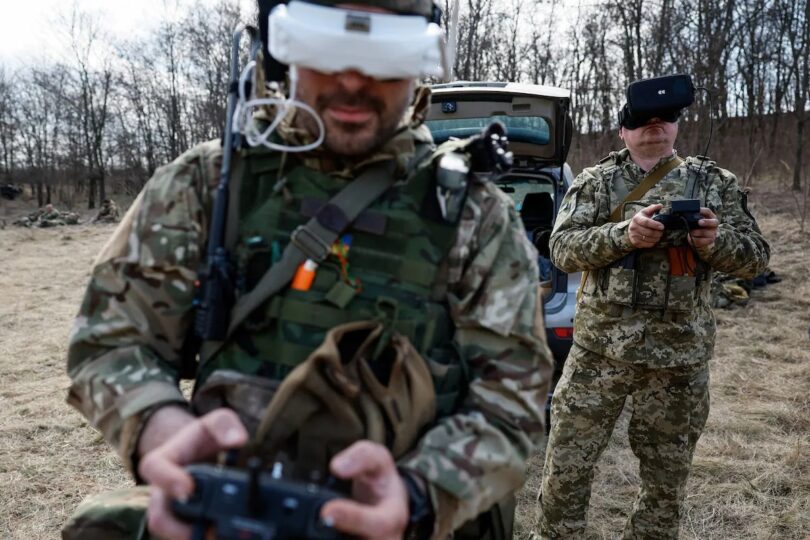Bina Venkataraman
Vancouver – Last week, the young technology billionaire Alexandr Wang asserted onstage at the annual TED conference that artificial intelligence will dominate the future of warfare. He urged democracies to invest in the next generation of weaponry. The Ukrainian military’s successful use of semiautonomous drones and machine learning to analyze satellite imagery, he argued, is precedent for wars involving killer drones that recognize people’s faces and autonomous fighter jets that travel at speeds intolerable for human pilots.
Just two weeks earlier, Gen. Mark A. Milley, chairman of the Joint Chiefs of Staff, made a very different pronouncement to the Senate Armed Services Committee. He praised the Ukrainians’ recent use of land mines as an “effective” battle tactic that had corralled Russian forces. How is it possible that killer robots powered by AI coexist with archaic weapons of 19th- and 20th-century warfare? The answer is: We are not asking enough of new technology.
Not just in war but in life, we are in a disorienting era in which old and new technologies are ever more frequently colliding. The disconnect between visions of tomorrow and the reality of present problems offers a rare opportunity to find a better way of thinking about innovation. It’s conventional wisdom that the future is here but unevenly distributed. This observation explains, for example, why, while Nigerians pay for groceries with bitcoin, I’ve recently had to scrounge up hard cash to pay for food and bus fare in major world cities.
But it doesn’t explain why land mines are used today by insurgents in conflict zones and by the Russian and Ukrainian militaries in their war, or why the United States still sanctions the use of land mines to defend South Korea. Here, the explanation is a lack of viable alternatives – or, viewed another way, a lack of innovation. The main reason that, over the past 30 years, the use of land mines has fallen has been not technology but the political will to ban the mines, said Stephen Goose, director of the arms division of Human Rights Watch. Since the late 1990s, 164 countries – including Ukraine, but notably not the United States, China or Russia – have banned land mines because of the way they kill warriors and civilians indiscriminately and because of their legacy of terror for decades after wars end, from Afghanistan to Angola. Military experts argue that land mines can be a force multiplier when an army is outmanned, by channeling armored attackers into a narrower area where precision missiles can take them out. Despite a 2001 study by the National Academies calling for innovation to end the use of land mines, technologies have lagged. (The United States has since favored self-deactivating mines with a limited life span, but even these are not compliant with the international ban because they do not discriminate between a child walking to school and an enemy fighter.)
The comeback of land mines exposes the myopia people suffer when talking about innovation. Today’s focus on autonomous drones and other advanced warfare technologies privileges the companies that make them, profit from them and justify going to battle with them. Some technologies will prove useful for defense and deterrence – for warding off cyberattacks, for instance, and competing with China’s military investments. But it’s equally important to start by defining the problems that new technologies should solve. Before betting on specific tools, even ones as expansive as AI, political and military leaders, technologists and the rest of us should ask what is needed to reduce the humanitarian costs of war, and the suffering in its aftermath. This could lead to innovations that would render land mines obsolete – in addition to unmanned fighter jets. Beyond war, too many debates about the future are dominated by isolated technologies rather than an investigation of how to live up to our values as humans. A better vision of the future hinges upon asking: What do we want the next technologies to do for people and society, and which antiquated technologies do we want to replace? Humanitarian researchers are showing us how this can work in practice. Even as progress on alternatives to land mines has stagnated, inventive ways to clean up mine fields are emerging. For three decades, the Halo Trust, a humanitarian organization, has been employing people around the world to clear mines by hand, using magnets and protective gear. (The State Department is contributing more than $60 million per year to Halo’s demining efforts.)
Michael Nevard, head of research and development at the Halo Trust, said he is hopeful that the mine fields in Ukraine might be cleared more quickly than those in prior conflicts. The organization is analyzing social media posts about mines and combining that work with images gathered by satellites and drones equipped with ground-penetrating radar, as well as on-the-ground interviews, to identify areas to be cleared. Separately, researchers in the United States seek to use thermal imaging, drones and machine learning to help determine where to dig for mines. I imagine that the late Ash Carter, former defense secretary and my friend, would have commended this innovation; he often called for getting “the good from technology without the bad.” He knew the market would not magically solve our greatest public problems. Entrepreneurs will continue to offer whatever is commercially viable, but when it comes to serving the public good, that’s doing things backward. It’s up to elected leaders and the public to define what is best for the future – in war and peace – and to summon the technologists, machines and tools to make it a reality.
The Washington Post







